When it comes to high-performance, durable cutting tools, carbide strips are often the go-to material for manufacturers. Whether you’re in the metalworking industry, woodworking, or need tools for other industrial applications, understanding the ins and outs of carbide strips and their manufacturers is crucial. Let’s delve into this fascinating topic and explore everything you need to know.
Overview of Carbide Strips
Carbide strips are renowned for their exceptional hardness, wear resistance, and ability to retain a sharp edge under extreme conditions. Typically used in cutting tools, wear-resistant applications, and various industrial equipment, these strips are crafted from a composite material consisting of carbide particles and a metallic binder, usually cobalt.
Key Features of Carbide Strips:
- Hardness: Superior hardness makes them ideal for cutting and wear applications.
- Wear Resistance: Excellent resistance to abrasion and wear.
- Toughness: Ability to withstand mechanical shocks.
- Heat Resistance: Retains properties at high temperatures.
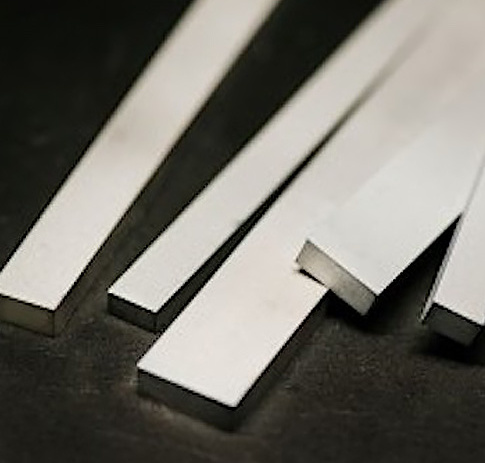
Types of Carbide Strips
To help you understand the different types of carbide strips available, here is a detailed table summarizing the various models:
| Model | Description |
|---|---|
| WC-6%Co | Tungsten carbide with 6% cobalt binder, high hardness, and moderate toughness. |
| WC-10%Co | Tungsten carbide with 10% cobalt, offering a balance between toughness and hardness. |
| WC-12%Co | Higher cobalt content for increased toughness and impact resistance. |
| WC-15%Co | Maximum toughness with significant cobalt content, used in heavy-duty cutting tools. |
| TiC-WC-Co | Titanium carbide added for enhanced wear resistance in challenging conditions. |
| CrC-WC-Co | Chromium carbide added for superior corrosion resistance and wear properties. |
| VC-WC-Co | Vanadium carbide included to improve grain size control and hardness. |
| WC-8%Co-Ni | Cobalt-nickel binder for increased toughness and corrosion resistance. |
| WC-8%Co-Cr | Cobalt-chromium binder for enhanced oxidation resistance. |
| WC-8%Co-Ta | Tantalum carbide addition for improved toughness and thermal stability. |
Applications of Carbide Strips
Carbide strips are employed in a variety of industrial applications. Here’s a table summarizing their typical uses:
| Application | Details |
|---|---|
| Metal Cutting | Utilized in lathe tools, milling cutters, and drills for their superior cutting capabilities. |
| Woodworking | Ideal for saw blades, router bits, and planers. |
| Mining | Used in mining tools for drilling and excavation. |
| Construction | Employed in cutting tools for concrete and stone. |
| Wear Parts | Used in high-wear environments like sandblasting nozzles and mechanical seals. |
| Textile Industry | Blades and cutters for textile manufacturing. |
| Paper and Pulp | Cutting tools for paper and pulp processing. |
| Plastic and Rubber | Blades for cutting plastic and rubber materials. |
| Glass Cutting | Tools for precision cutting of glass. |
| Electronics | Precision cutting tools for electronic components. |
Material Properties of Carbide Strips
Understanding the material properties of carbide strips is essential for selecting the right type for your application. Here is a table summarizing key material properties:
| Property | Value |
|---|---|
| Hardness | 89 – 94 HRA (Rockwell A Hardness) |
| Density | 14.5 – 15.2 g/cm³ |
| Transverse Rupture Strength | 2500 – 3500 MPa |
| Young’s Modulus | 500 – 700 GPa |
| Thermal Conductivity | 50 – 110 W/m·K |
| Thermal Expansion Coefficient | 4.5 – 6.5 µm/m·K |
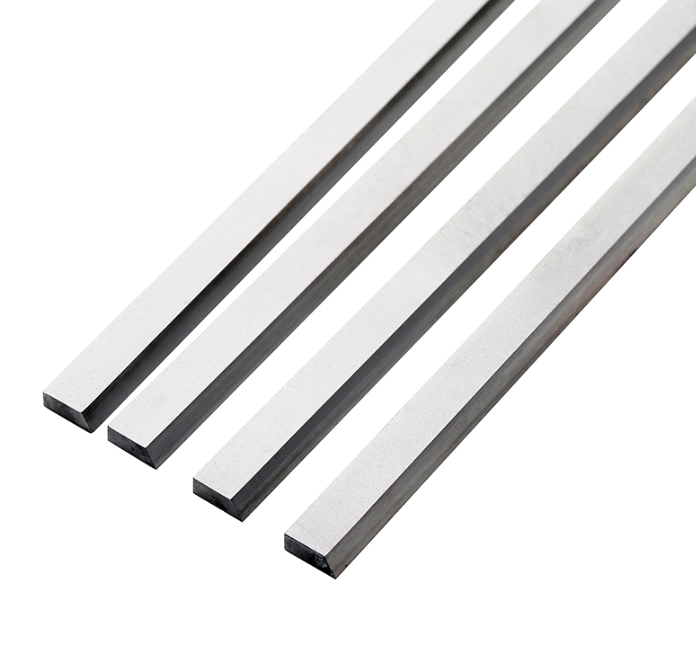

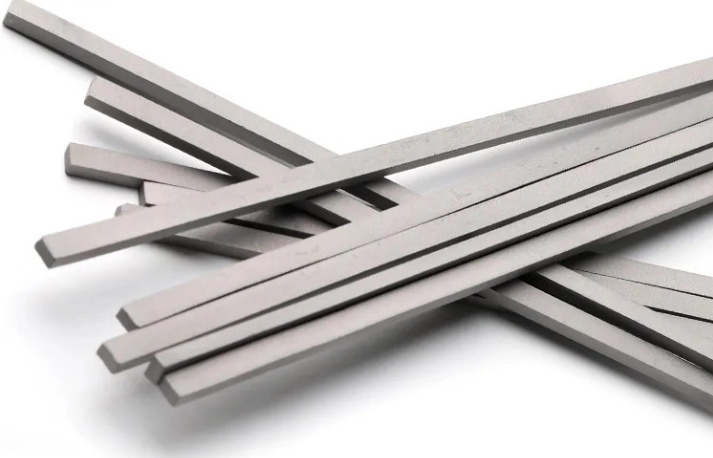

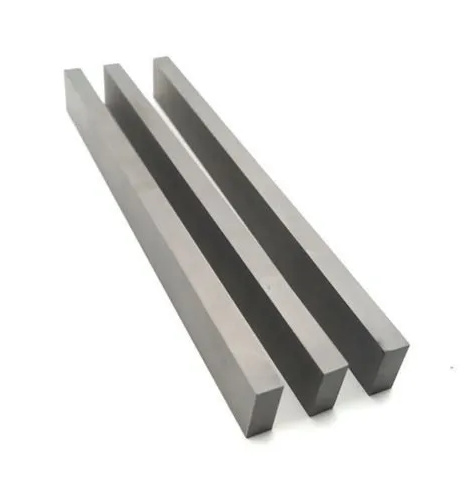
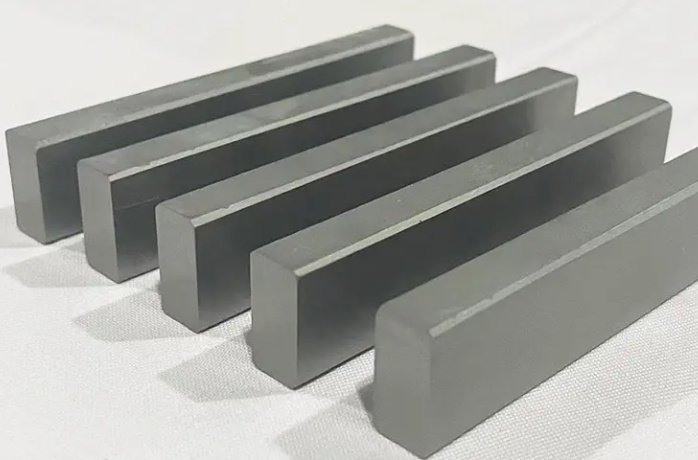
Composition and Characteristics of Carbide Strips
The composition of carbide strips varies depending on the intended application. Here is a table detailing their composition, properties, and characteristics:
| Model | Composition | Properties | Characteristics |
|---|---|---|---|
| WC-6%Co | Tungsten Carbide, 6% Cobalt | High hardness, moderate toughness | Balanced performance |
| WC-10%Co | Tungsten Carbide, 10% Cobalt | Good hardness and toughness | Versatile use |
| WC-12%Co | Tungsten Carbide, 12% Cobalt | Increased toughness | Suitable for impact-prone applications |
| WC-15%Co | Tungsten Carbide, 15% Cobalt | Maximum toughness | Heavy-duty tools |
| TiC-WC-Co | TiC, Tungsten Carbide, Cobalt | Enhanced wear resistance | High abrasion environments |
| CrC-WC-Co | CrC, Tungsten Carbide, Cobalt | Superior corrosion resistance | Corrosive conditions |
| VC-WC-Co | VC, Tungsten Carbide, Cobalt | Improved grain size and hardness | Precision tools |
| WC-8%Co-Ni | Tungsten Carbide, 8% Cobalt, Nickel | Increased toughness, corrosion resistance | Versatile, durable |
| WC-8%Co-Cr | Tungsten Carbide, 8% Cobalt, Chromium | Enhanced oxidation resistance | High-temperature applications |
| WC-8%Co-Ta | Tungsten Carbide, 8% Cobalt, Tantalum | Improved thermal stability | High-heat environments |
Hardness, Strength, and Wear Resistance
When choosing carbide strips, hardness, strength, and wear resistance are critical parameters. Here’s a comparative table of these properties:
| Model | Hardness (HRA) | Strength (MPa) | Wear Resistance |
|---|---|---|---|
| WC-6%Co | 92 | 3200 | High |
| WC-10%Co | 90 | 3000 | High |
| WC-12%Co | 88 | 2900 | Moderate |
| WC-15%Co | 86 | 2800 | Moderate |
| TiC-WC-Co | 93 | 3100 | Very High |
| CrC-WC-Co | 91 | 3000 | High |
| VC-WC-Co | 92 | 3200 | High |
| WC-8%Co-Ni | 90 | 3100 | High |
| WC-8%Co-Cr | 90 | 3100 | High |
| WC-8%Co-Ta | 91 | 3150 | High |
Specifications, Sizes, and Standards
Carbide strips come in various sizes and adhere to certain standards. Here’s a detailed table of specifications:
| Specification | Details |
|---|---|
| Standard Sizes | Length: 100-300 mm, Width: 10-30 mm, Thickness: 1-10 mm |
| Shape | Rectangular, Square, Customized shapes |
| Tolerance | ±0.05 mm for length, ±0.02 mm for width and thickness |
| Standards | ISO 9001, ASTM B777, DIN ISO 3313 |
Suppliers and Pricing Details
Selecting a reliable supplier is critical for ensuring quality and performance. Here is a table summarizing some of the top suppliers and their pricing:
| Supplier | Location | Pricing (USD per kg) | Special Features |
|---|---|---|---|
| Kennametal | USA | 50 – 100 | High-quality, custom solutions |
| Sandvik | Sweden | 45 – 95 | Wide range, excellent durability |
| Ceratizit | Luxembourg | 40 – 90 | Innovative products, great performance |
| Zhuzhou Cemented Carbide | China | 30 – 70 | Cost-effective, reliable |
| Hyperion Materials | USA | 50 – 110 | High precision, custom sizes |
How to Select the Right Carbide Strips Manufacturer
Choosing the right manufacturer can make a significant difference in the performance and lifespan of your carbide strips. Here’s a guide to help you make an informed decision:
| Criteria | Considerations |
| Reputation | Look for manufacturers with a strong reputation and positive reviews. |
| Quality Standards | Ensure they comply with international quality standards like ISO 9001. |
| Customization | Check if they offer customization options for specific needs. |
| Technical Support | Opt for suppliers who provide robust technical support and after-sales service. |
| Pricing | Compare pricing to ensure you get the best value for your money without compromising quality. |
| Lead Time | Consider the manufacturer’s lead time for delivery. |
| Experience | Manufacturers with extensive experience in the industry are often more reliable. |
Comparing Advantages and Limitations of Carbide Strips
To help you understand the pros and cons, here’s a comparative table:
| Aspect | Advantages | Limitations |
|---|---|---|
| Hardness | Very hard, maintains sharpness | Can be brittle under high impact |
| Wear Resistance | Exceptional wear resistance | Higher initial cost |
| Heat Resistance | Performs well under high temperatures | Requires precise manufacturing techniques |
| Versatility | Suitable for a wide range of applications | May need specific handling and usage |
| Cost | Long-term cost-effective | Higher upfront investment |

FAQ
What are carbide strips made of?
Carbide strips are made from tungsten carbide particles bound together with a metallic binder, typically cobalt.
What are the key benefits of using carbide strips?
The main benefits include superior hardness, wear resistance, toughness, and heat resistance, making them ideal for cutting and wear applications.
How are carbide strips used in different industries?
They are used in metal cutting, woodworking, mining, construction, and various other industries that require durable cutting and wear-resistant tools.
What should I consider when selecting a carbide strip manufacturer?
Consider the manufacturer’s reputation, quality standards, customization options, technical support, pricing, lead time, and experience in the industry.
Can carbide strips be customized?
Yes, many manufacturers offer customization options to meet specific application needs, including custom shapes and sizes.
Conclusion
Choosing the right carbide strips and a reliable manufacturer is crucial for ensuring the success and efficiency of your industrial applications. With the detailed information provided in this guide, you are well-equipped to make informed decisions that will enhance your operations. Whether you need carbide strips for cutting, wear resistance, or specialized industrial applications, understanding the types, properties, and factors for selecting a manufacturer will help you achieve the best results.



